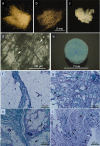Bioactive glass-based fibrous wound dressings
- PMID: 36196303
- PMCID: PMC9519693
- DOI: 10.1093/burnst/tkac038
Bioactive glass-based fibrous wound dressings
Abstract
Since the discovery of silicate bioactive glass (BG) by Larry Hench in 1969, different classes of BGs have been researched over decades mainly for bone regeneration. More recently, validating the beneficial influence of BGs with tailored compositions on angiogenesis, immunogenicity and bacterial infection, the applicability of BGs has been extended to soft tissue repair and wound healing. Particularly, fibrous wound dressings comprising BG particle reinforced polymer nanofibers and cotton-candy-like BG fibers have been proven to be successful for wound healing applications. Such fibrous dressing materials imitate the physical structure of skin's extracellular matrix and release biologically active ions e.g. regenerative, pro-angiogenic and antibacterial ions, e.g. borate, copper, zinc, etc., that can provoke cellular activities to regenerate the lost skin tissue and to induce new vessels formation, while keeping an anti-infection environment. In the current review, we discuss different BG fibrous materials meant for wound healing applications and cover the relevant literature in the past decade. The production methods for BG-containing fibers are explained and as fibrous wound dressing materials, their wound healing and bactericidal mechanisms, depending on the ions they release, are discussed. The present gaps in this research area are highlighted and new strategies to address them are suggested.
Keywords: Angiogenesis; Bioactive glass; Fibers; Scaffolds; Wound healing.
© The Author(s) 2022. Published by Oxford University Press.
Figures




Similar articles
-
Preparation of copper-containing bioactive glass/eggshell membrane nanocomposites for improving angiogenesis, antibacterial activity and wound healing.Acta Biomater. 2016 May;36:254-66. doi: 10.1016/j.actbio.2016.03.011. Epub 2016 Mar 7. Acta Biomater. 2016. PMID: 26965395
-
Biocomposites of copper-containing mesoporous bioactive glass and nanofibrillated cellulose: Biocompatibility and angiogenic promotion in chronic wound healing application.Acta Biomater. 2016 Dec;46:286-298. doi: 10.1016/j.actbio.2016.09.021. Epub 2016 Sep 17. Acta Biomater. 2016. PMID: 27646503
-
Sol-gel derived B2O3-CaO borate bioactive glasses with hemostatic, antibacterial and pro-angiogenic activities.Regen Biomater. 2023 Nov 25;11:rbad105. doi: 10.1093/rb/rbad105. eCollection 2024. Regen Biomater. 2023. PMID: 38173772 Free PMC article.
-
Opportunities for Bioactive Glass in Gastrointestinal Conditions: A Review of Production Methodologies, Morphology, Composition, and Performance.Mol Pharm. 2023 Dec 4;20(12):5954-5980. doi: 10.1021/acs.molpharmaceut.3c00188. Epub 2023 Nov 14. Mol Pharm. 2023. PMID: 37962352 Review.
-
Immunomodulatory bioactive glasses for tissue regeneration.Acta Biomater. 2021 Oct 1;133:168-186. doi: 10.1016/j.actbio.2021.08.023. Epub 2021 Aug 18. Acta Biomater. 2021. PMID: 34418539 Review.
Cited by
-
Green Electrospun Poly(vinyl alcohol)/Gelatin-Based Nanofibrous Membrane by Incorporating 45S5 Bioglass Nanoparticles and Urea for Wound Dressing Applications: Characterization and In Vitro and In Vivo Evaluations.ACS Omega. 2024 May 2;9(19):21187-21203. doi: 10.1021/acsomega.4c01102. eCollection 2024 May 14. ACS Omega. 2024. PMID: 38764625 Free PMC article.
-
Advances in copper-containing biomaterials for managing bone-related diseases.Regen Biomater. 2025 Mar 18;12:rbaf014. doi: 10.1093/rb/rbaf014. eCollection 2025. Regen Biomater. 2025. PMID: 40259976 Free PMC article. Review.
-
Exploring the frontiers: The potential and challenges of bioactive scaffolds in osteosarcoma treatment and bone regeneration.Mater Today Bio. 2024 Sep 29;29:101276. doi: 10.1016/j.mtbio.2024.101276. eCollection 2024 Dec. Mater Today Bio. 2024. PMID: 39444939 Free PMC article. Review.
-
Exploring nanobioceramics in wound healing as effective and economical alternatives.Heliyon. 2024 Sep 26;10(19):e38497. doi: 10.1016/j.heliyon.2024.e38497. eCollection 2024 Oct 15. Heliyon. 2024. PMID: 39391491 Free PMC article. Review.
-
Bioactive-Glass-Based Materials with Possible Application in Diabetic Wound Healing: A Systematic Review.Int J Mol Sci. 2024 Jan 17;25(2):1152. doi: 10.3390/ijms25021152. Int J Mol Sci. 2024. PMID: 38256225 Free PMC article.
References
-
- Tronci G. The application of collagen in advanced wound dressings. In: Rajendran S (eds). Advanced Textiles for Wound Care. Duxford, United Kingdom: Woodhead Publishing-Elsevier, 2019, 363–89.
Publication types
LinkOut - more resources
Full Text Sources
Miscellaneous

